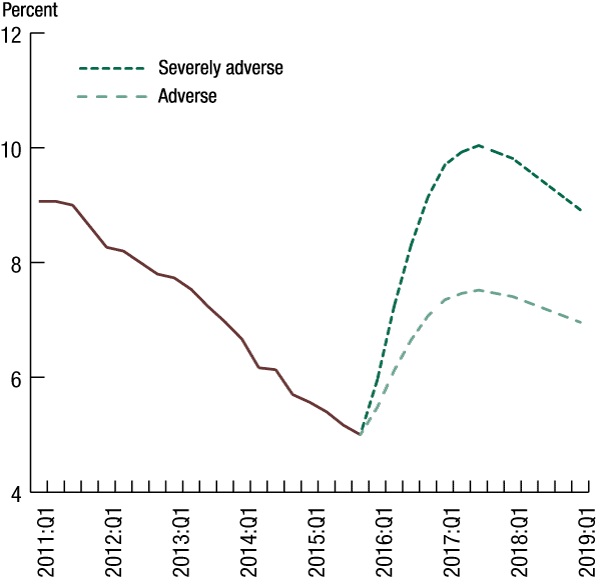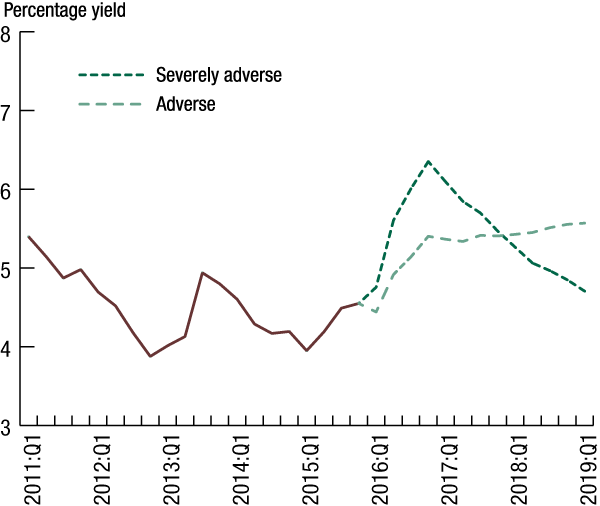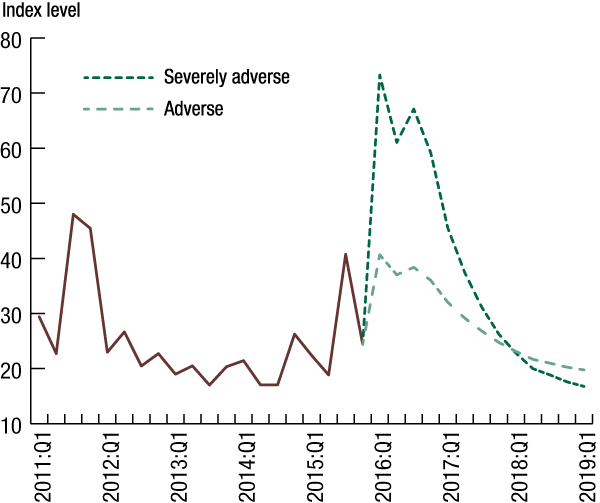Dodd-Frank Act Stress Test 2016: Supervisory Stress Test Methodology and Results
Supervisory Scenarios
On January 28, 2016, the Federal Reserve released the three supervisory scenarios: baseline, adverse, and severely adverse.13 This section describes the adverse and severely adverse scenarios that were used for the projections contained in this report. These scenarios were developed using the approach described in the Board's Policy Statement on the Scenario Design Framework for Stress Testing.14 The adverse and severely adverse scenarios are not forecasts, but rather hypothetical scenarios designed to assess the strength of banking organizations and their resilience to an unfavorable economic environment.
Supervisory scenarios include trajectories for 28 variables. These include 16 variables that capture economic activity, asset prices, and interest rates in the U.S. economy and financial markets and three variables (real gross domestic product (GDP) growth, inflation, and the U.S./foreign currency exchange rate) in each of the four countries/country blocs.
Similar to last year, the Federal Reserve applied a global market shock to the trading portfolio of six BHCs with large trading and private equity exposures and a counterparty default scenario component to eight BHCs with substantial trading, processing, or custodial operations (see Global Market Shock and Counterparty Default Components).
Severely Adverse Scenario
Figures 2 through 7 illustrate the hypothetical trajectories for some of the key variables describing U.S. economic activity and asset prices under the severely adverse scenario.
The severely adverse scenario is characterized by a severe global recession accompanied by a period of heightened corporate financial stress and negative yields for short-term U.S. Treasury securities. In this scenario, the level of U.S. real GDP begins to decline in the first quarter of 2016 and reaches a trough in the first quarter of 2017 that is 6.25 percent below the pre-recession peak. The unemployment rate increases by 5 percentage points, to 10 percent, by the middle of 2017, and headline consumer price inflation rises from about 0.25 percent at an annual rate in the first quarter of 2016 to about 1.25 percent at an annual rate by the end of the recession.
Asset prices drop sharply in the scenario, consistent with the developments described above. Equity prices fall approximately 50 percent through the end of 2016, accompanied by a surge in equity market volatility, which approaches the levels attained in 2008. House prices and commercial real estate prices also experience considerable declines, with house prices dropping 25 percent through the third quarter of 2018 and commercial real estate prices falling 30 percent through the second quarter of 2018. Corporate financial conditions are stressed severely, reflecting mounting credit losses, heightened investor risk aversion, and strained market liquidity conditions; the spread between yields on investment-grade corporate bonds and yields on long-term Treasury securities increases to 5.75 percent by the end of 2016.
As a result of the severe decline in real activity and subdued inflation, short-term Treasury rates fall to negative 0.50 percent by mid-2016 and remain at that level through the end of the scenario. For the purposes of this scenario, it is assumed that the adjustment to negative short-term interest rates proceeds with no additional financial market disruptions. The 10-year Treasury yield drops to about 0.25 percent in the first quarter of 2016, rising gradually thereafter to reach about 0.75 percent by the end of the recession in early 2017 and about 1.75 percent by the first quarter of 2019.
The international component of this scenario features severe recessions in the euro area, the United Kingdom, and Japan, and a mild recession in developing Asia. As a result of acute economic weakness, all foreign economies included in the scenario experience a pronounced decline in consumer prices. Reflecting flight-to-safety capital flows during weak economic conditions, the U.S. dollar is assumed to appreciate against the euro, the pound sterling, and the currencies of developing Asia. The dollar is assumed to depreciate modestly against the yen, also in line with flight-to-safety capital flows.

Source: Bureau of Labor Statistics and Federal Reserve assumptions in the supervisory scenarios.

Source: Bureau of Economic Analysis and Federal Reserve assumptions in the supervisory scenarios.
Figure 4. Dow Jones Total Stock Market Index, end of quarter in the severely adverse and adverse scenarios, 2011:Q1-2019:Q1

Source: Dow Jones and Federal Reserve assumptions in the supervisory scenarios.

Source: CoreLogic (seasonally adjusted by Federal Reserve) and Federal Reserve assumptions in the supervisory scenarios.
Figure 6. U.S. BBB corporate yield, quarterly average in the severely adverse and adverse scenarios, 2011:Q1-2019:Q1

Source: Merrill Lynch (adjusted by Federal Reserve using a Nelson-Siegel smoothed yield curve model) and Federal Reserve assumptions in the supervisory scenarios.
Figure 7. U.S. Market Volatilty Index (VIX) in the severely adverse and adverse scenarios, 2011:Q1-2019:Q1

Source: Chicago Board Options Exchange (converted to quarterly by Federal Reserve using the maximum quarterly close-of-day value) and Federal Reserve assumptions in the supervisory scenarios.
Compared to last year's scenario, this year's severely adverse scenario features a more severe downturn in the U.S. economy. The more severe downturn in activity assumed in the scenario reflects the Federal Reserve's scenario design framework for stress testing, which includes countercyclical elements. Under this framework, the unemployment rate in the severely adverse scenario will reach a peak of at least 10 percent, which leads to a progressively greater increase in the unemployment rate when its starting level falls below 6 percent. In line with the more severe U.S. recession, this year's severely adverse scenario also features a path of negative short-term U.S. Treasury rates. In turn, lower Treasury rates moderate the drop in asset prices and the increase in market volatility, compared to last year's scenario. Furthermore, this year's scenario does not feature the pronounced increase in inflation that was featured in last year's scenario.
Adverse Scenario
Figures 2 through 7 illustrate the hypothetical trajectories for some of the key variables describing U.S. economic activity and asset prices under the adverse scenario.
The adverse scenario is characterized by weakening economic activity across all countries or country blocs included in the scenario. The economic downturn is accompanied by a period of deflation in the United States and in the other countries and country blocs. The adverse scenario features a moderate U.S. recession that begins in the first quarter of 2016. Real GDP in the United States falls 1.75 percent from the pre-recession peak in the fourth quarter of 2015 to the recession trough in the first quarter of 2017, while the unemployment rate rises steadily, peaking at 7.50 percent in the middle of 2017. The U.S. recession is accompanied by a mild deflationary period with consumer prices falling about 0.50 percent over the four quarters of 2016. Reflecting weak economic conditions and deflationary pressures, short-term interest rates in the United States remain near zero over the projection period. The 10-year Treasury yield declines to 1.25 percent in early 2016 before rising gradually thereafter to 3 percent in the first quarter of 2019.
Financial conditions tighten for corporations and households during the recession, with spreads between investment-grade corporate bond yields and 10-year Treasury yields and spreads between mortgage rates and 10-year Treasury yields widening through the end of 2016. Asset prices decline in the adverse scenario. Equity prices fall approximately 25 percent through the fourth quarter of 2016, accompanied by a moderate rise in equity market volatility. Aggregate house prices and commercial real estate prices experience moderate declines; commercial real estate prices fall 12 percent through the third quarter of 2017 and house prices fall 12 percent through the third quarter of 2018. Following the end of the recession in the United States, real activity picks up slowly at first and then gains speed; real U.S. GDP growth rises from 1.25 percent at an annual rate in the second quarter of 2017 to 3 percent at an annual rate by the middle of 2018. The unemployment rate declines modestly to about 7 percent by the end of the scenario period. Consumer prices begin to rise slowly in the first quarter of 2017 and inflation remains subdued through the end of the scenario window. Consumer price inflation reaches 1.75 percent at an annual rate in the first quarter of 2019.
Outside of the United States, the adverse scenario features moderate recessions in the euro area, the United Kingdom, and Japan, as well as below-trend growth in developing Asia. Weakness in global demand results in deflation across all of the foreign economies under consideration as well as a broad-based decline in commodity prices. Headline consumer prices decline modestly through the end of 2016 in the euro area and the United Kingdom and decline through the middle of 2017 in developing Asia. Japan experiences a sharper and more prolonged deflationary period with prices falling through the second quarter of 2018. The U.S. dollar appreciates relative to the currencies of the countries and country blocs under consideration, reflecting flight-to-safety capital flows; the dollar appreciates most strongly against the euro and the currencies of developing Asia.
The main difference relative to the 2015 adverse scenario is that this year's adverse scenario features a decline in the consumer price index (CPI)--i.e., deflation--in the United States. Deflation in the euro area and Japan was featured as a component of the 2015 adverse scenario, but that scenario also featured a considerable rise in headline U.S. inflation. In this year's adverse scenario, U.S. deflation implies substantially different paths of U.S. Treasury yields relative to the paths in last year's scenario. In this year's scenario, the yield curve is lower and initially flatter than under baseline assumptions but then steepens over the scenario period. In last year's scenario, by contrast, the yield curve was higher and flatter than under baseline assumptions.
Global Market Shock and Counterparty Default Components
The Federal Reserve applied a global market shock to the trading portfolio of six BHCs with large trading and private equity exposures.15 In addition, the Federal Reserve applied a counterparty default component, which assumes the default of a BHC's largest counterparty under the global market shock, to the same six BHCs and two other BHCs with substantial trading, processing, or custodial operations.16 These components are an add-on to the macroeconomic conditions and financial market environment specified in the adverse and severely adverse scenarios.
The global market shock is a set of one-time, hypothetical shocks to a broad range of financial market risk factors. Generally, these shocks involve large and sudden changes in asset prices, interest rates, and spreads, reflecting general market dislocation and heightened uncertainty.17 The Federal Reserve published the global market shock for the adverse and severely adverse scenarios on February 4, 2016; the as-of date for the global market shock and the counterparty default is January 4, 2016.
The severely adverse scenario's global market shock is designed around three main elements: a sudden sharp increase in general risk premiums and credit risk; significant market illiquidity; and the distress of one or more large entities that rapidly sell a variety of assets into an already fragile market. Liquidity deterioration is most severe in those asset markets that are typically less liquid, such as corporate debt and private equity markets, and is less pronounced in those markets that are typically more liquid, such as publicly traded equity and U.S. Treasury markets. Markets facing a significant deterioration in liquidity experience conditions that are generally comparable to the peak-to-trough changes in asset valuations during the 2007-09 period. The severity of deterioration reflects the market conditions that could occur in the event of a significant pullback in market liquidity in which market participants are less able to engage in market transactions that could offset and moderate the price dislocations. Declines in markets less affected by the deterioration in liquidity conditions are generally comparable to those experienced in the second half of 2008.
Worsening liquidity also leads prices of related assets that would ordinarily be expected to move together to diverge markedly. In particular, the valuation of certain cash market securities and their derivative counterparts--so-called basis spreads--fail to move together because the normal market mechanics that would ordinarily result in small pricing differentials are impeded by a lack of market liquidity. Notably, option-adjusted spreads on agency mortgage-backed securities (MBS) increase significantly. Illiquidity-driven dislocations between the cash and to-be-announced (TBA) forward markets result in larger increases in the option-adjusted spreads on securities than in the TBA market. Similarly, relationships between the prices of other financial assets that would normally be expected to move together come under pressure and are weakened.
Globally, government bond yield curves undergo marked shifts in level and shape due to market participants' increased risk aversion. The flight-to-quality and lack of liquidity in affected markets pushes risk-free rates down across the term structure in the United States, with some short-term rates dropping below zero. The yield curves for government bonds flatten or invert across Europe and Asia while volatility increases across the term structure. The potential for a prolonged and more acute recession in Europe drives up sovereign credit spreads in the euro zone periphery in a manner generally consistent with the experience of 2011. Emerging market countries with deteriorating economic and fiscal accounts would also experience a sharp increase in sovereign spreads.
The major differences relative to the 2015 severely adverse scenario include (1) a larger widening in credit spreads for municipal, sovereign, and advanced economies' corporate products; (2) generally, greater declines in the value of private equity investments, recently issued securitized products, and non-agency residential MBS; (3) a more severe widening in basis spreads between closely related assets such as agency MBS and TBA forwards as well as corporate bonds and credit default swaps; and (4) a general decline in U.S. Treasury rates, resulting in negative short-term rates, while short-term government rates in Europe rise to positive or slightly negative levels, and Asian government rates across the term structure flatten or invert. These differences are intended to reflect the result of a more significant drop in liquidity than was assumed in the 2015 severely adverse scenario.
The global market shock component for the adverse scenario simulates an extended low-growth environment and muted market volatility across most asset classes and term structures. Domestic interest rates move lower, particularly for longer-maturity securities with lower volatility. Due to reduced demand, global commodity prices decline moderately. MBS and credit spreads widen moderately. Internationally, yield curves move lower and flatten, while sovereign credit spreads widen moderately. Select currency markets also experience small flight-to-quality moves. Equity markets experience a mild correction with a measured increase in volatility.
The major difference relative to the 2015 adverse scenario is the addition of elements that are distinct from and not mechanically linked to the severely adverse scenario. In particular, the 2016 adverse scenario includes (1) more muted changes in price, spread, and volatility levels across most markets; and (2) a general decline in U.S. Treasury rates, with short-term government rates rising in most other countries and regions while long-term rates decline.
The eight BHCs with substantial trading or custodial operations were also required to incorporate a counterparty default scenario component into their supervisory adverse and severely adverse stress scenarios. These BHCs were required to estimate and report the potential losses and related effects on capital associated with the instantaneous and unexpected default of the counterparty that would generate the largest losses across their derivatives and securities financing activities, including securities lending, and repurchase or reverse repurchase agreement activities.
References
13. See Board of Governors of the Federal Reserve System (2016), "2016 Supervisory Scenarios for Annual Stress Tests Required under the Dodd-Frank Act Stress Testing Rules and the Capital Plan Rule" (Washington, DC: Board of Governors, January 28), http://www.federalreserve.gov/newsevents/press/bcreg/bcreg20160128a2.pdf for additional information and for the details of the supervisory scenarios. Return to text
14. 12 CFR part 252, appendix A. Return to text
15. The six BHCs subject to the global market shock are Bank of America Corporation; Citigroup Inc.; The Goldman Sachs Group, Inc.; JPMorgan Chase & Co.; Morgan Stanley; and Wells Fargo & Co. See 12 CFR 252.54(b)(2). Return to text
16. The eight BHCs subject to the counterparty default component are Bank of America Corporation; The Bank of New York Mellon Corporation; Citigroup Inc.; The Goldman Sachs Group, Inc.; JPMorgan Chase & Co.; Morgan Stanley; State Street Corporation; and Wells Fargo & Co. See 12 CFR 252.54(b)(2). Return to text
17. See CCAR 2016: Severely Adverse Market Shocks at www.federalreserve.gov/bankinforeg/CCAR-2016-Severely-Adverse-Market-Shocks.xlsx, and CCAR 2016: Adverse Market Shocks at www.federalreserve.gov/bankinforeg/CCAR-2016-Adverse-Market-Shocks.xlsx. Return to text
